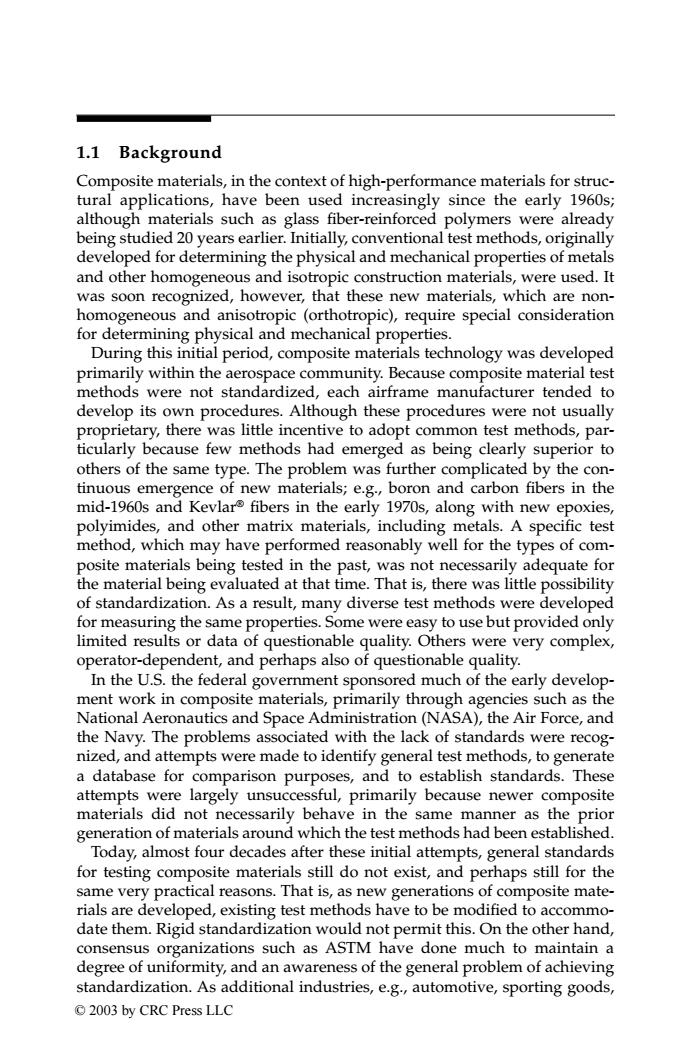正在加载图片...

1.1 Background Composite materials,in the context of high-performance materials for struc- tural applications,have been used increasingly since the early 1960s; although materials such as glass fiber-reinforced polymers were already being studied 20 years earlier.Initially,conventional test methods,originally developed for determining the physical and mechanical properties of metals and other homogeneous and isotropic construction materials,were used.It was soon recognized,however,that these new materials,which are non- homogeneous and anisotropic (orthotropic),require special consideration for determining physical and mechanical properties. During this initial period,composite materials technology was developed primarily within the aerospace community.Because composite material test methods were not standardized,each airframe manufacturer tended to develop its own procedures.Although these procedures were not usually proprietary,there was little incentive to adopt common test methods,par- ticularly because few methods had emerged as being clearly superior to others of the same type.The problem was further complicated by the con- tinuous emergence of new materials;e.g.,boron and carbon fibers in the mid-1960s and Kevlar fibers in the early 1970s,along with new epoxies, polyimides,and other matrix materials,including metals.A specific test method,which may have performed reasonably well for the types of com- posite materials being tested in the past,was not necessarily adequate for the material being evaluated at that time.That is,there was little possibility of standardization.As a result,many diverse test methods were developed for measuring the same properties.Some were easy to use but provided only limited results or data of questionable quality.Others were very complex, operator-dependent,and perhaps also of questionable quality. In the U.S.the federal government sponsored much of the early develop- ment work in composite materials,primarily through agencies such as the National Aeronautics and Space Administration(NASA),the Air Force,and the Navy.The problems associated with the lack of standards were recog- nized,and attempts were made to identify general test methods,to generate a database for comparison purposes,and to establish standards.These attempts were largely unsuccessful,primarily because newer composite materials did not necessarily behave in the same manner as the prior generation of materials around which the test methods had been established. Today,almost four decades after these initial attempts,general standards for testing composite materials still do not exist,and perhaps still for the same very practical reasons.That is,as new generations of composite mate- rials are developed,existing test methods have to be modified to accommo- date them.Rigid standardization would not permit this.On the other hand, consensus organizations such as ASTM have done much to maintain a degree of uniformity,and an awareness of the general problem of achieving standardization.As additional industries,e.g.,automotive,sporting goods, ©2003 by CRC Press LLC1.1 Background Composite materials, in the context of high-performance materials for structural applications, have been used increasingly since the early 1960s; although materials such as glass fiber-reinforced polymers were already being studied 20 years earlier. Initially, conventional test methods, originally developed for determining the physical and mechanical properties of metals and other homogeneous and isotropic construction materials, were used. It was soon recognized, however, that these new materials, which are nonhomogeneous and anisotropic (orthotropic), require special consideration for determining physical and mechanical properties. During this initial period, composite materials technology was developed primarily within the aerospace community. Because composite material test methods were not standardized, each airframe manufacturer tended to develop its own procedures. Although these procedures were not usually proprietary, there was little incentive to adopt common test methods, particularly because few methods had emerged as being clearly superior to others of the same type. The problem was further complicated by the continuous emergence of new materials; e.g., boron and carbon fibers in the mid-1960s and Kevlar® fibers in the early 1970s, along with new epoxies, polyimides, and other matrix materials, including metals. A specific test method, which may have performed reasonably well for the types of composite materials being tested in the past, was not necessarily adequate for the material being evaluated at that time. That is, there was little possibility of standardization. As a result, many diverse test methods were developed for measuring the same properties. Some were easy to use but provided only limited results or data of questionable quality. Others were very complex, operator-dependent, and perhaps also of questionable quality. In the U.S. the federal government sponsored much of the early development work in composite materials, primarily through agencies such as the National Aeronautics and Space Administration (NASA), the Air Force, and the Navy. The problems associated with the lack of standards were recognized, and attempts were made to identify general test methods, to generate a database for comparison purposes, and to establish standards. These attempts were largely unsuccessful, primarily because newer composite materials did not necessarily behave in the same manner as the prior generation of materials around which the test methods had been established. Today, almost four decades after these initial attempts, general standards for testing composite materials still do not exist, and perhaps still for the same very practical reasons. That is, as new generations of composite materials are developed, existing test methods have to be modified to accommodate them. Rigid standardization would not permit this. On the other hand, consensus organizations such as ASTM have done much to maintain a degree of uniformity, and an awareness of the general problem of achieving standardization. As additional industries, e.g., automotive, sporting goods, TX001_ch01_Frame Page 2 Saturday, September 21, 2002 4:47 AM © 2003 by CRC Press LLC